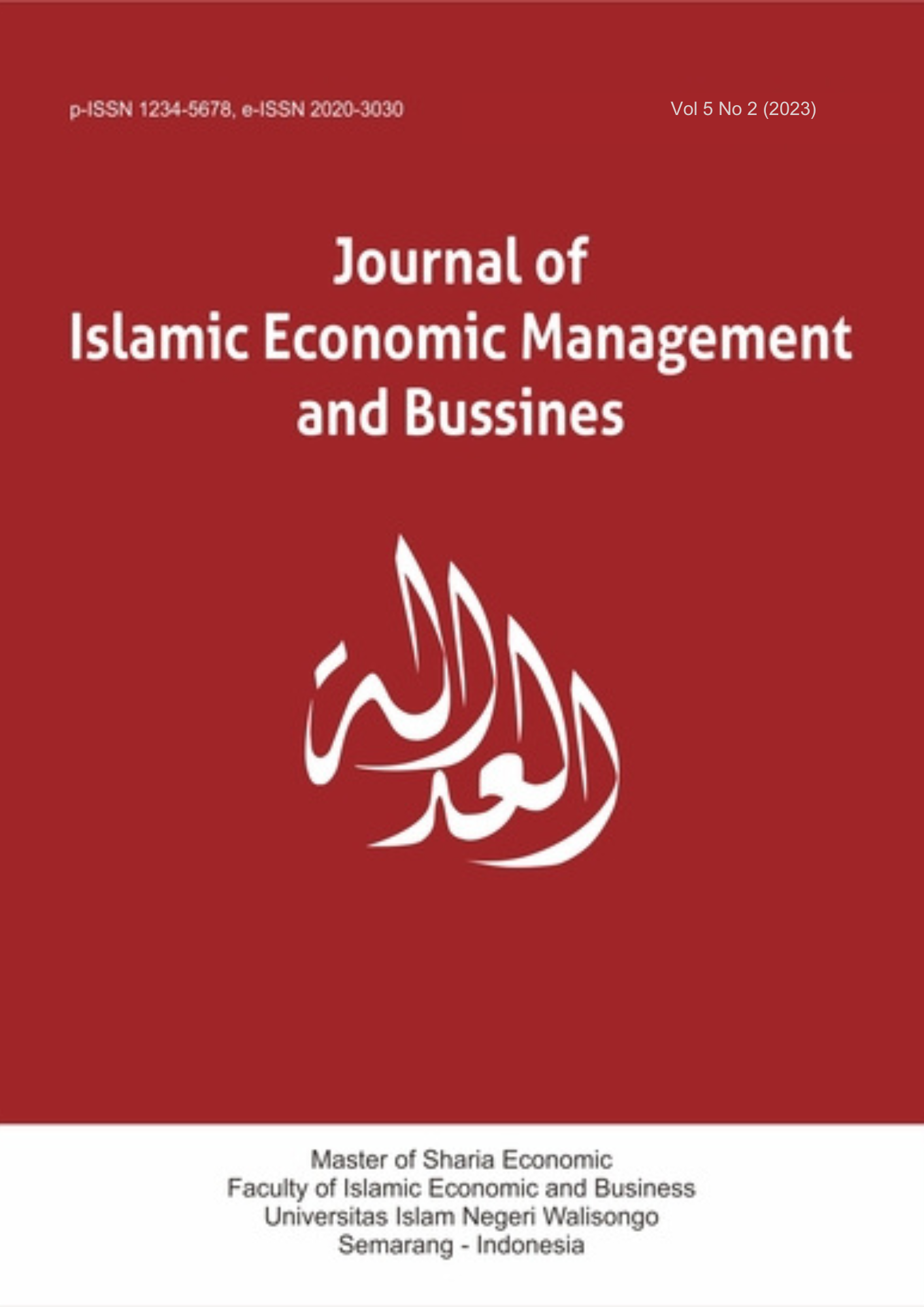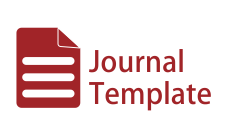Debt repayment practices among rural farmers: An Islamic economic perspective
DOI:
https://doi.org/10.21580/jiemb.2023.5.2.21582Keywords:
Islamic economics, qarḍ al-ḥasan, debt repayment, rural finance, rice loan practices.Abstract
This study focuses on the practice of debt repayment with rice in Martadah Village, Tambang Ulang District, Tanah Laut Regency, where the majority of the population are rice farmers. The primary aim of this study is to examine this practice from an Islamic economic perspective. The research employs a qualitative descriptive method involving observations, interviews, and documentation analysis related to the debt repayment practices in the village. The findings reveal that the debt repayment with rice often does not align with the qarḍ principles in Islamic economics, as the price of rice set by lenders is lower than the market price, causing losses to the farmers. The study also identifies the farmers’ dependency on capital owners and local community leaders, creating power dynamics and potential exploitation. Some cases show fairer practices consistent with qarḍ principles, where debt repayment is done at market prices without interest or additional profits. This study provides practical and theoretical contributions by emphasizing the importance of education and the application of Islamic economic principles to ensure fairness and social welfare in rural communities.
Downloads
References
Abdullah, M. (2015). Analysing the Moral Aspect of Qard: A Shariah Perspective. International Journal of Islamic and Middle Eastern Finance and Management, 8(2), 171-184. http://dx.doi.org/10.1108/IMEFM-11-2013-0116
Abdul-Rahim, Wahab, & Yusoff. (2019). Impact of Shariah-Compliant Status on Firms’ Decision to Practice Forex Hedging. Journal of Islamic Accounting and Business Research, 10(5), 756-769. https://doi.org/10.1108/jiabr-06-2016-0076
Aldeen, K. N., Ratih, I. S., & Herianingrum, S. (2020). Contemporary Issues on Cash Waqf: A Thematic Literature Review. International Journal of Islamic Economics and Finance (IJIEF), 3(3). https://doi.org/10.18196/ijief.3236
Ashafa, S. A. (2021). Riba (interest) between reason and revelation in Islam. Journal of Islamic Economic and Business Research, 1(2), 180-192. https://doi.org/10.18196/jiebr.v1i2.18
Bernhardt, D. (1989). Money and Loans. The Review of Economic Studies, 56(1), 89–100. https://doi.org/10.2307/2297751
Burke, J. (2009). Usury Redux: Notes on The Scholastic Analysis of Usury by John T. Noonan,. Working Papers 0901, Ave Maria University, Department of Economics.
Clary, B.J. (2011). Institutional Usury and the Banks. Review of Social Economy, 69(4), 419-438. https://doi.org/10.1080/00346764.2011.622906
Ehikioya, B. I., Omankhanlen, A. E., Osuma, G. O., & Inua, O. I. (2020). Dynamic Relations Between Public External Debt and Economic Growth in African Countries: A Curse or Blessing?. Journal of Open Innovation: Technology, Market, and Complexity, 6(3), 1-16. https://doi.org/10.3390/joitmc6030088
Eyerci, C. (2021). Basics of Islamic Economics and the Prohibition of Riba. The Causes and Consequences of Interest Theory, 87-130, Springer. https://doi.org/10.1007/978-3-030-78702-8_6
Hakim, L. (2022). Tafsir Riba di Media Sosial Perspektif Roy Shakti dan Arli Kurnia. Ekoma Jurnal Ekonomi Manajemen Akuntansi, 1(2), 312-325. https://doi.org/10.56799/ekoma.v1i2.300
Halaby, M. (2022). Riba According to The Al-Quran View: Thematic Tafsir Study About Riba Verses. International Journal of Islamic Thought and Humanities, 1(1), 17–26. https://doi.org/10.54298/ijith.v1i1.12
Hermawan, F. (2020). Praktek Hutang Uang Dibayar Beras di Desa Durian Sebatang Kecamatan Kedurang Kabupaten Bengkulu Selatan Perspektif Ekonomi Islam. Institut Agama Islam Negeri Bengkulu.
Iffah, F., & Yasni, Y. F. (2022). Manusia Sebagai Makhluk Sosial. Lathaif: Literasi Tafsir, Hadis dan Filologi, 1(1), 38-47. https://dx.doi.org/10.31958/lathaif.v1i1.5926
Ikafitria, R., Wahid, S. H., Islami, L. I., & Putri, R. Z. (2022). Akad Qardh Perspektif Fatwa DSN-MUI tentang Qardh: Studi Kasus pada Gabungan Kelompok Tani Ngudi Makmur Magetan. Jurnal Antologi Hukum, 2(2), 301-317. https://doi.org/10.21154/antologihukum.v2i2.1333
Ismiwati, B. (2023). Pemberdayaan Masyarakat Berbasis Potensi Lokal dalam Upaya Meningkatkan Perekonomian Keluarga di Desa Telaga Waru Kecamatan Labuapi. Jurnal Abdimas Independen, 4(2), 118-125. https://doi.org/10.29303/independen.v4i2.819
Jaya, I. M. L. M. (2020). Metode Penelitian Kuantitatif dan Kualitatif: Teori, Penerapan, dan Riset Nyata. Bantul-Yogyakarta: Anak Hebat Indonesia.
Kisworo, S. (2023). Hukum Riba dan Perbankan di Indonesia. Mizanuna, 1(2), 1-16. https://doi.org/10.59166/mizanuna.v1i2.56
Maryanto, M. A., Hariani, R., & Aripto, S. (2021). Analisis Pelaksanaan Pelunasan Hutang-Piutang Pupuk Dibayar Dengan Beras Dalam Pandangan Hukum Islam Di Desa Niur Kecamatan Muara Pinang Kabupaten Empat Lawang. Ekonomica Sharia: Jurnal Pemikiran dan Pengembangan Ekonomi Syariah, 6(2), 167-198. https://doi.org/10.36908/esha.v6i2.206
McCall, B. M. (2008). Unprofitable Lending: Modern Credit Regulation and the Lost Theory of Usury. Cardozo Law Review, 30(2), retrified from https://ssrn.com/abstract=1098954
Muhlisah, S. (2020). Sistem Utang Piutang Pupuk Dibayar Gabah di Jember Perspektif Fiqih Muamalah dan Hukum Positif. Rechtenstudent, 1(3), 285-292. https://doi.org/10.35719/rch.v1i3.37
Masciandaro, D. (2002). Why Shylock Can Be Efficient? A Theory of Usury Contracts. Kredit und Kapital, 3, retrified from: https://ssrn.com/abstract=279008
Meriyati & Nugraha, S.L. (2022). Konsep Al-Qur’an dan Hadist tentang Riba Dan Bunga Bank. Jurnal Justisia Ekonomika, 6(1), 379-389. https://doi.org/10.30651/justeko.v6i1.11209
Nasution, A. M. (2018). Batasan Mengambil Keuntungan Menurut Hukum Islam. El-Qonuniy: Jurnal Ilmu-ilmu Kesyari’ahan dan Pranata Sosial 4(1), https://doi.org/10.24952/el-qonuniy.v4i1.1829
Nawir, M. (2021). Kontekstualisasi Pemahaman Hadis Nabi tentang Riba. Tadayun: Jurnal Hukum Ekonomi Syariah, 2(2), 101-116. https://doi.org/10.24239/tadayun.v2i2.23
Olmedo, L., Van Twuijver, M., & O’Shaughnessy, M. (2023). Rurality as Context for Innovative Responses to Social Challenges – The Role of Rural Social Enterprises. Journal of Rural Studies, 99, 272–283. https://doi.org/10.1016/j.jrurstud.2021.04.020
Putra, I. (2022). Al-Qardh dalam Prespektif Al-Qur'an dan Hadits Serta Hubungannya Dengan Riba. Jurnal Ekonomi Rabbani, 2(1), https://dx.doi.org/10.53566/jer.v2i1.87
Qureshi, I., & Liaqat, Z. (2020). The Long-Term Consequences of External Debt: Revisiting the Evidence and Inspecting the Mechanism Using Panel VARs. Journal of Macroeconomics, 63(5), 103-184. https://doi.org/10.1016/j.jmacro.2019.103184
Rahmawati, F., Ulama’I, A. H. A. & Din, M. (2022). Riba in the Perspective of Sharia Bank Customers: A Systematic Literature Review. Velocity: Journal of Sharia Finance and Banking, 2(1), 73–90. https://doi.org/10.28918/velocity.v2i1.5422
Riwanto, A. & Suryaningsih, S. (2022). Realizing Welfare State and Social Justice: A Perspective on Islamic Law. Volksgeist: Jurnal Ilmu Hukum dam Konstitusi, 5(1), 41-51. https://doi.org/10.24090/volksgeist.v5i1.6430
Sahdan, S. (2023). Konsep Bunga Bank dalam Al-Qur’an Menurut Yusuf Al-Qaradhawi dan Muhammad Sayyid Thanthawi. Comserva Jurnal Penelitian Dan Pengabdian Masyarakat, 3(6), 2073-2086. https://doi.org/10.59141/comserva.v3i06.1012
Selim, M. (2019). The effectiveness of Qard-al-Hasan (interest free loan) as a tool of monetary policy. International Journal of Islamic and Middle Eastern Finance and Management, 12(1), 130-151. https://doi.org/10.1108/IMEFM-07-2017-0187
Sunardi, D. (2015). Pelaksanaan Utang-Piutang Antara Bandar Padi Dengan Petani di Desa Jambenenggang Kecamatan Kebonpedes Kabupaten Sukabumi. UIN Sunan Gunung Djati Bandung.
Triyawan, A. (2014). Konsep Qard dan Rahn Menurut Fiqh al-Madzhahib. Ijtihad, 8(1), 51-68. https://doi.org/10.21111/ijtihad.v8i1.2587
Tumiwa, K., Lohlker, R., & Samad, T. (2022). The Discourse of Usury in the Views of Islam and Christianity. Tasharruf Journal Economics and Business of Islam, 7(2), 185. https://doi.org/10.30984/tjebi.v7i2.2314
Zwolinski, M. (2013). Are Usurious? Another New Argument for the Prohibition of High Interest Loans? Business Ethics Journal Review 1(4):22-27. https://doi.org/10.12747/bejr2013.01.04
Downloads
Published
Issue
Section
License
Authors who publish with this journal agree to the following terms:
Authors retain copyright and grant the journal right of first publication with the work simultaneously licensed under a Creative Commons Attribution-ShareAlike 4.0 International License that allows others to share the work with an acknowledgement of the work's authorship and initial publication in this journal.
Authors are able to enter into separate, additional contractual arrangements for the non-exclusive distribution of the journal's published version of the work (e.g., post it to an institutional repository or publish it in a book), with an acknowledgement of its initial publication in this journal.
Authors are permitted and encouraged to post their work online (e.g., in institutional repositories or on their website) prior to and during the submission process, as it can lead to productive exchanges, as well as earlier and greater citation of published work (See The Effect of Open Access).



